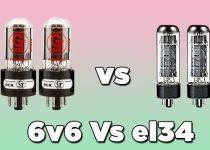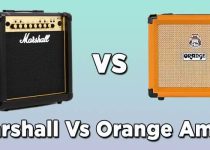6bq5 Vs 6v6 [Difference & Which is better]
In the realm of vacuum tubes, the 6BQ5 and 6V6 tubes stand as iconic components that have significantly shaped the world of audio amplification. These tubes have been the foundation of countless musical experiences, providing distinct tonal characteristics and performance capabilities.
This article delves deep into the intricacies of the 6BQ5 vs 6V6 tubes, highlighting their differences and aiding in the quest to determine which tube might be the better choice for various audio applications.

# Table of Contents =>
Understanding the Basics:
Before we delve into the differences between the 6BQ5 and 6V6 tubes, let’s establish a fundamental understanding of each tube’s specifications and historical context.
6BQ5 Tube:

The 6BQ5, also known as the EL84, is a power pentode tube that gained prominence in the 1950s. It was widely used in amplifiers for audio and guitar applications due to its compact size, moderate power output, and distinctive harmonic content. With a lower plate dissipation and smaller physical footprint, the 6BQ5 became a favorite among manufacturers seeking to create compact yet powerful amplifiers.
6V6 Tube:

The genesis of the 6V6 can be traced back to the 1930s, where it emerged as a beam tetrode tube. Initially conceived for applications in radio equipment, its utility expanded over time to encompass guitar amplifiers and audio systems. Notably, the 6V6 tube has gained acclaim for its harmoniously warm tonal attributes, rendering it a prized selection among aficionados of classic audio gear.
Main Difference Between the 6bq5 Vs 6v6:
When comparing the 6BQ5 and 6V6 tubes, several aspects come into play that can influence the overall listening experience and tonal output.
a) Tonal Characteristics:
Undoubtedly, the pivotal element influencing the decision-making quandary lies in the tonal distinctions between these two tubes. Frequently, the 6BQ5 is depicted as harboring an assertive and finely detailed upper register, fostering heightened lucidity within the midrange frequencies.
Conversely, the 6V6 boasts a reputation for its mellower, well-rounded auditory profile, underscored by a pronounced focus on the midrange. This particular trait infuses the audio output with an inviting and enveloping warmth.
b) Power Output:
The power output of these tubes also differs substantially. The 6BQ5 typically offers a lower wattage output compared to the 6V6. Consequently, the 6BQ5 emerges as the prime contender for scenarios permitting lower power thresholds. Which is including deployment within recording studios and domestic audio configurations.
Conversely, the 6V6’s elevated power output positions it as the optimal preference for expansive venues and circumstances demanding augmented headroom capacity.
c) Distortion and Saturation:
Both tubes exhibit unique distortion characteristics. The 6BQ5 tends to distort more readily and can produce a more aggressive overdrive when pushed. This property has made it a favorite among guitarists seeking a raw and edgy sound. In contrast, the 6V6 offers a smoother and more gradual saturation. That is making it a preferred choice for enthusiasts of blues and jazz genres.
d) Durability and Availability:
The availability of tubes and their longevity are practical considerations when selecting between the 6BQ5 and 6V6. The 6V6, being an older design, has a longer track record and is generally more readily available in the market. However, the 6BQ5’s compact design has allowed it to find a niche in modern manufacturing, ensuring a relatively steady supply.
e) Application Scenarios
To determine which tube is better, one must consider the specific application and the desired sonic outcome.
6BQ5’s Ideal Applications:
The 6BQ5 tube finds its strength in scenarios where its aggressive and articulate tonal characteristics shine. Guitarists looking for a cutting and defined sound, particularly in genres like rock and metal, might lean towards the 6BQ5. Additionally, its lower power output makes it suitable for recording setups, bedroom amplifiers, and situations where volume control is crucial.
6V6’s Ideal Applications:
For those seeking a warmer and more vintage tonal palette, the 6V6 tube is an excellent choice. Its smooth midrange and gradual distortion make it a favorite among blues, jazz, and classic rock enthusiasts. The 6V6’s higher power output also makes it more adept at driving larger speakers and handling higher volume situations, making it a preferred option for live performances.
Conclusion:
In the eternal debate of 6BQ5 vs 6V6, there is no definitive answer as to which tube is better. Both the 6BQ5 and 6V6 tubes offer unique tonal characteristics and performance attributes that cater to different preferences and applications. The decision ultimately boils down to the sonic profile you desire and the specific context in which the tubes will be employed.
Whether you’re chasing aggressive distortion or seeking vintage warmth, both tubes have left an indelible mark on the world of audio amplification. This is ensuring that the choice between them will continue to inspire passionate discussions among audiophiles and musicians alike.
FAQs –
Q. What are the 6BQ5 and 6V6 tubes?
A: The 6BQ5 and 6V6 are vacuum tubes widely used in audio amplification. The 6BQ5, also known as EL84, is a power pentode tube that gained popularity in the 1950s. The 6V6, on the other hand, is a beam tetrode tube dating back to the 1930s, originally designed for radio equipment.
Q. Which tube is better for distortion?
A: If you’re seeking action distortion, the 6BQ5 is the preferred choice. It distorts more readily and can produce a raw, edgy overdrive when pushed, making it a favorite among guitarists in genres like rock and metal.
Q. Which tube is suitable for a warm and vintage sound?
A: For a warm and vintage sound, the 6V6 tube is a better option. Its smooth midrange and gradual saturation make it a popular choice among enthusiasts of blues, jazz, and classic rock genres.
Q. Can I mix these tubes in the same amplifier?
A: Mixing tubes in the same amplifier is generally not recommended. Each tube has its own characteristics that contribute to the overall tone of the amplifier. Mixing different tubes could result in imbalanced sound and potential technical issues.
Q. Which tube should I choose for my guitar amplifier?
A: The choice between the 6BQ5 and 6V6 tubes for your guitar amplifier depends on your musical style and preferences. If you’re aiming for a cutting and sound, the 6BQ5 might be more suitable. For a warmer, vintage tone, the 6V6 is a better fit.
Last Updated on September 10, 2023 by Perry Garner


